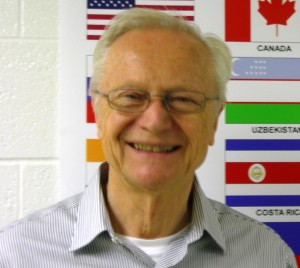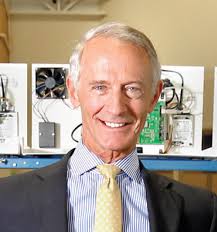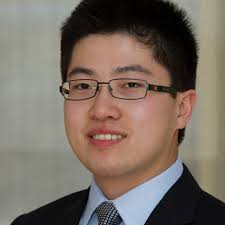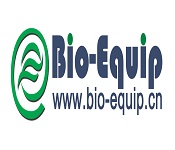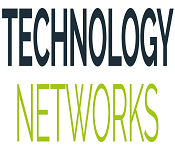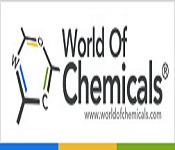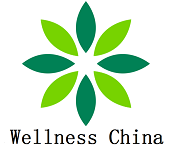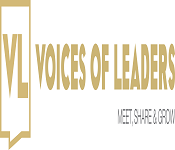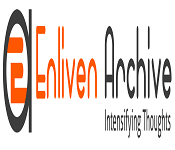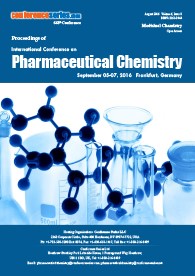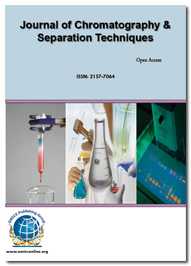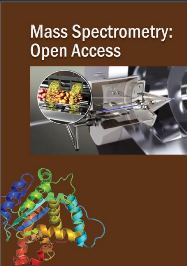Theme: Advancements and Scope of Spectroscopy in Modern Chemistry
Global Spectroscopy 2019
Conference Series LLC Ltd invites all the participants from all over the world to take part and attend Global Spectroscopy 2019 Conference on October 17-18, 2019 in Bangkok, Thailand..
Global Spectroscopy 2019 is a great platform to unite and share the knowledge with eminent speakers, academicians and industrialists about the aspects of Mass Spectroscopy. The conference highlights the in-depth knowledge of mass spectrometric principles.
The conference would bring together the people interested in fields of mass spectrometry, analytical chemistry to explore new ideas and replica concerned to relevant topics and generate solutions to decipher the huge shade of Mass Spectrometry.
Conference Series LLC Ltd organizes 1000+ conferences every year across USA, Europe & Asia with support from 1000 more scientific societies and publishes 900+ Open access journals which contains 6000 eminent personalities, reputed scientists and editorial board members.
Who to attend?
· Directors of analytical chemistry department in Universities
· Research laboratories Scientist
· Professor and Associate professor of analytical chemistry
· Research scholars
· Analytical instrument manufacturing company
· Research and Development Department
Why to attend???
- To learn about key issues in the industry (and your area of interest in particular) as articulated by practitioners.
- To meet people and organizations addressing these same key issues.
- To meet people with whom you’ve established a relationship on social media.
- To initiate relationships with others that you can continue by social media and/or meetings in person.
- To learn about job, internship, project and other work-based possibilities.
- To learn about fellowship and grant opportunities relevant to your area(s) of interest.
- To gain insight into the experiences of others who face challenges like yours.
- To learn about publications and other resources relevant to your area(s) of interest.
Target Audience:
· Industry 30%
· Academia 60%
· Others 10%
Conference Keywords
- Liquid Chromatography
- Gas liquid chromatography
- Mass Spectroscopy
- Ionization
- Biomolecules
- Genetic Disorders
- Combinatorial Chemistry
- Agro-Chemistry
- Bioanalysis
- Forensic Chemistry
- Food technology
- Electrospray Ionization
- Atmospheric pressure chemical ionization
- Hyphenation
- Pharmaceutical Research
- Biomedical Research
- Post-translational modification
- Liquid–liquid extraction
- Chromatography and High-Performance Liquid Chromatography (HPLC)
- Therapeutics
1. Liquid Chromatography is a different method of analytical chemistry which is mainly used to separate and identify each element in a mixture. Now a days highly used technique is HPLC (High Pressure Liquid Chromatography) which has been used for production of Pharmaceutical and biological products. Is has different phase like stationary phase that is the type of absorbent material used as the stationary phase is vital for efficient separation of components in mixture and mobile phase which is chosen for the best separation of components in an unknown mixture.
2. Gas liquid chromatography is an analytical machine that measures the content of various components in a sample. The principle of gas chromatography is to inject the solution into the instrument and enter gas stream which take the sample up to the separation tube or column where helium or nitrogen gas is used. The work of detector is to measure the quantity of the components that exit the column and compared with the known sample to check results.
3. Mass Spectroscopy is a technique which is used for ionizes chemical compounds. This process is highly used in separation technique. Gas chromatography is used to separate different compounds. MS is highly common use in analytical laboratories that studied in physical although in chemical properties. MS generates different ions from the sample then separates them according to their mass-to-charge ratio. The MS instrument consists three major components like Ion Source, Analyzer, Detector System. This mass spectroscopy technique is basically studied the effect of ionizing energy on molecules.
4. Ionization is a process by which atoms and molecules exchange their positive and negative charge to form an ion by changing the chemical composition also. Ionization is highly used in fundamental science mainly in Analytical chemistry, Mass spectroscopy. In chemistry ionization often occurs in a liquid solution. In general, it occurs whenever sufficiently energetic charged particles or rediant energy travel through gases, liquids or solids. It is used in Ionizing radiation , Ionized water filter, Alkaline water ionizer and in others.
5. Biomolecules are biological molecule, that are produced by cells organic molecules especially macromolecules like carbohydrates, proteins in living organisms. All living things like bacteria, algae, plant and animals are made of similar macromolecules that are biomolecules. There are different types of biomolecules like small molecules include Lipids, fatty acid, Vitamins, Monomers etc. MS becoming an necessary field to analyze biomolecules. The desorption ionization based on the emission of pre-existing ions such as plasma desorption (PD), fast atom bombardment (FAB) or laser desorption (LD), allowed mass spectrometry for analyzing complex biomolecules. It includes Nucleic acid biomolecule, DNA biomolecules etc.
6.Genetic Disorders: it is caused because of abnormality in an individual's genome also caused by heredity. The abnormality range can be from minor to major. It causes by new changes in DNA. This create Single-gene problem. This also cause multifactorial and polygenic which cause heart disease or diabetes.
7. Combinatorial Chemistry includes large group of structural diverse compounds. This technique contain chemical synthetic method to prepare large number of compounds in a single process. It is used to synthesis small molecules and peptides. The methods of combinational chemistry are used outside chemistry too. It includes in drug discovery, dynamic chemistry and screening impact factor also.
8. Agro-Chemistry is the part of Chemistry and Biochemistry that is important in agricultural production. The aim of this chemistry is to relate plant and animal growth. Its another aim is to increase the fertility of soil. The important branch of this agro-chemistry is Chemurgy which is concerned chiefly with agricultural product as raw materials.
9. Bioanalysis covers the quantitative measurement of drug and their metabolites, concentrations etc. It measures the small molecule. Bioanalysis technique includes liquid chromatography–mass spectrometry, capillary electrophoresis–mass spectrometry, ultra-performance liquid chromatography etc. it is mainly focused on measuring small molecules of drugs. There are several international organizations are doing research on bioanalysis like European Bioanalysis Forum, Royal Netherlands Chemical Society.
10. Therapeutics is the response which is happen after treatment of any kind of therapy. It is the part of medicine concerned with the treatment of disease and the action of remedial agents.
11. Forensic Chemistry is the part of chemistry and it is a legal setting. This field involves the identification and quantitative analysis if scientific evidence. The forensic chemistry assists the identification of crime. The methods mainly used for forensic chemistry include HPLC, GCMS, Atomic absorption spectroscopy etc. Forensic toxicology is a part of Forensic chemistry which study on pharmacodynamics that what a substance does to a body.
12. Food technology is a scientific research for preservation of food. It is very helpful for food supply and that change the world. Developments in food technology is a big contribution for the whole world. Different process is including for this developments like Freeze-Drying, High temperature short time processing, Process optimization, Decaffeination etc. The food processing industries are involved in processes such as primary, secondary, processing, preservation, quality management, packaging, labeling.
13. Electrospray Ionization is the process which is used in mass spectroscopy to produce ion in electrospray. High voltage to apply in liquid to create an aerosol. It is used to produce ions from macromolecules. Mass spectroscopy using ESI is called electrospray ionization mass spectroscopy. It is a soft ionization technique. ESI is used to study protein folding and to test presence of nanoclusters.
14. Atmospheric pressure chemical ionization is an ionization process which is used in mass spectroscopy and in HPLC. The main uses of APCI is thermal stable samples with low to medium molecular weight, medium and high polarity.
15. Hyphenation is a separation technique which refer to combination of two or more techniques to separate chemicals from solutions. The main thing related to Hyphenation is Mass spectrometry, Electrochemical analysis, Hybrid techniques , etc.
16. Pharmaceutical Research is a relating to medicinal drugs and industries which discovers develops and produces drugs for uses. For making this it need variety of laws and regulation. Drug discovery, Drug development, pharmaceutical drugs is the part of Pharmaceutical research. Each Pharmaceutical companies are doing their research on different drugs to create something new.
17. Biomedical Research is the application of engineering principles and concepts of medicine and healthcare. It is a field that develops methods, tools. It is related to medical biological science. It has a different part like Tissue Engineering, Genetic Engineering, Pharmaceutical Engineering, Clinical Engineering. Clinical and Pre-clinical both research phase exists in Biomedical Research and is oriented towards a specific pharmaceutical purpose.
18. Post-translational modification is the enzymatic modification of proteins. This mainly happen in amino acid side chains. Some of them are consists of cleaving peptide bonds and some types are consequences of oxidative stress. PTM can be detected by different techniques like MS, Eastern blotting and Western blotting. It includes Post translational modification prediction, Post translational modification in eukaryotes etc.
19. Liquid–liquid extraction is a method to separate two different immiscible liquids based on their relative solubilities. LLE is possible in non-aqueous systems also as a system consisting of a molten metal in contact with molten salts. The solution which is to be extracted is called the feed, and the liquid with which feed is contacted is the solvent. In petroleum industry Extraction process is well used. Other application is in biochemical, pharmaceutical industries for antibiotics and protein recovery.
20. Chromatography and High Performance Liquid Chromatography (HPLC): Liquid chromatography-mass spectrometry analysis of small molecules from biofluids requires sensitive and robust assays. Because of the very complex nature of many biological samples, efficient sample preparation protocols to remove unwanted components and to selectively extract the compounds of interest are an essential part of almost every bioanalytical workflow. High-performance liquid chromatography (HPLC) is a separation technique that can be used for the analysis of organic molecules and ions. HPLC is based on mechanisms of adsorption, partition and ion exchange, depending on the type of stationary phase used. HPLC involves a solid stationary phase, normally packed inside a stainless-steel column, and a liquid mobile phase. Separation of the components of a solution results from the difference in the relative distribution ratios of the solutes between the two phases. HPLC can be used to assess the purity and/or determine the content of many pharmaceutical bioprocessing substances.
Track1. New approaches in Mass Spectroscopy:
Mass spectrometry (MS) is one of the major analytical techniques which ionizes chemical species and sorts out based on their mass-to-charge ratio of the ions. In general, it can be expressed as, a mass spectrum which measures the masses within a sample. This spectrometry is used in many other different fields which are applied to pure samples along with complex mixtures. Some of the new approaches in Mass Spectrometry are:
- Materializing separation Technologies
- Hybrid Mass Spectrometry
- Paths in glycoproteins and glycans
- Tom Probe Tomography
- Protein Phosphorylation and Non-Covalent interaction
- Overture in isolation, enrichment and separation
- Structural proteomics and genomics
- Lipidomic, metabolomics and ultra-trace analysis
- Complementary Multi technique Access
- Mass spectrometry in the field of food science
- New MS technologies in Metabolomics/Lipidomics
- Biomolecular, Carbohydrates, and microbe analysis
- Nano scale and microfluidic separations
- High temperature Mass Spectrometry
Track 2. UV Spectroscopy:
Ultraviolet Spectroscopy is the measurement of the decrease in the beam of light after passing through a sample or after reflection from a sample surface. Absorption measurements can be at a single wavelength or over an extended spectral range.
- Functional Groups
- Qualitative Analysis
- Instrumentation
- Sample handling and Measurements
- Method development & Validation
Track 3. Time-Resolved (TR) Spectroscopy:
Time-resolved spectroscopy is the study of dynamic processes in materials or chemical compounds by means of spectroscopic techniques. Most often, processes are studied after the illumination of a material occurs, but in principle, the technique can be applied to any process that leads to a change in properties of a material.
- Light sources for Ultrafast Spectroscopy
- Time-resolved fluorescence
- Time-resolved fluorescence - Biological applications
- Pump-probe spectroscopy - Transient Absorption measurements
- Application of Transient Absorption - Investigation of biological processes
Track 4. X-Ray Spectroscopy:
There are different ways in which X-rays can be employed. Absorption of X-rays is about absorbing material in other regions of the spectrum. Fluorescence emission of X-rays enables to identify and measure heavy elements in any medium. Diffraction of X-rays enables to analyse the specificity and accuracy of crystalline materials with a high degree.
- X-Ray Emission Spectroscopy
- Auger Emission Spectroscopy
- X-Ray Fluorescence Spectroscopy
- Electron Spectroscopy – Chemical Analysis (ESCA)
- X-Ray Absorption Spectroscopy
- X-Ray Diffraction Spectroscopy
Track 5. NMR Spectroscopy:
Nuclear Magnetic Resonance (NMR) is a spectroscopy technique which is based on the absorption of electromagnetic radiation by nuclei of the atoms. Proton Nuclear magnetic resonance spectroscopy is one of the most powerful tools for elucidating the number of hydrogen or proton in the compound. It is used to study a wide variety of nuclei.
- Nuclear Spin
- Detecting the Signal: Fourier Transform NMR Spectrometers
- Shielding and Deshielding of Protons
- Chemical Shift
- Chemical Shift Equivalent and Non-equivalent Protons
- Signal Splitting: Spin–Spin Coupling
- Two-Dimensional (2D) NMR Techniques
- Proton NMR Spectroscopy
- Carbon NMR Spectroscopy
Track 6. EPR Spectroscopy:
EPR (Electron Paramagnetic Resonance) is a spectroscopic technique that detects species that have unpaired electrons. It is also called as ESR (Electron Spin Resonance). A large number of materials have unpaired electrons which include free radicals, many transition metal ions, and defects. Free electrons are often short-lived, but still play vital roles in many processes such as photosynthesis, oxidation, catalysis, and polymerization reactions. As a result EPR crosses several disciplines like chemistry, physics, biology, materials science, medical science and many more.
- ERI - Electron Resonance Imaging
- Hyperfine Splitting
- EPR spin-trapping technique
- EPR spin-labelling
- Analytical Applications
- Biological Applications
Track 7. Terahertz Spectroscopy:
Terahertz spectroscopy is a rapidly evolving field with interesting applications in medical imaging, security, scientific imaging (chemistry, biochemistry and astronomy), communications, and manufacturing. Many molecules, especially biomolecules, provide fingerprint spectroscopic lines in the Terahertz region
- Terahertz Spectrum
- Terahertz Sources
- Ultrafast laser spectroscopy
- Frequency-Domain terahertz
- Pulsed Terahertz Techniques
- Applications
Track 8. Chromatography:
Chromatography Mass Spectrometry, different method for identifying and separating the components, or solutes, of a mixture on the basis of the relative amounts of each solute distributed between a moving fluid streams, called the mobile phase, and a contiguous stationary phase. Liquid-chromatography is one of the mostly employed and useful techniques in pharmaceutical industry for sample preparation. Another one is electrophoretic separation technique designed for rapid and selective sample analysis. Immuno affinity chromatography (IAC) is a different method of Liquid Chromatography in which the stationary phase consists of an antibody or it might include antibody-related reagent. This technique involves a unique sub type of affinity chromatography, in which a biologically related binding agent is taken for the selective separation or analysis of a target compound. Capillary electrophoresis is other method which identifies and distributes ions depending on their electrophoretic mobility with the use of an applied voltage. Compact mass spectrometer is widely used in the food safety, water purity and clinical diagnosis. Gas chromatography mass spectrometry (GC/MS) is an instrumental technique, comprising a gas chromatograph (GC) coupled to a mass spectrometer (MS), by which complex mixtures of chemicals may be separated, identfied and quantified.
- Liquid chromatography
- Gas chromatography
- Column chromatography
- Planar chromatography
- Thin layer chromatography
- Ion exchange chromatography
- Latest techniques in Chromatography
Track 9. Luminescence Spectroscopy:
Luminescence spectroscopy is a technique which studies the of chemical systems. Luminescence is the emission of light by a substance. It occurs when an electron returns to the electronic ground state from an excited state and loses its excess energy as a photon. Luminescence spectroscopy is a collective name given to three related spectroscopic techniques.
- Fluorescence
- Internal and External Conversion
- Intersystem Crossing
- Phosphorescence
- Chemiluminescence
Track 10. High Performance Liquid Chromatography/Applications of High resolution Mass Spectrometry(HPLC)
HPLC/UHPLC chromatography is a commonly used separation mode in Reversed phase. Its retention of compounds possessing hydrophobic and organic functionality are provided dynamically. Combination of both hydrophobic and van der Waals type interactions between all the target compounds including both the stationary and mobile phases enables by reversed phase retention of these compounds. HPLC can be used in the following applications:
- Ultra high performance liquid chromatography
- Fast protein liquid chromatography
- HPLC-mass spectrometry
- Characterization of HPLC stationary phases
Track 11. Spectroscopy tools in Nanotechnology:
Nanoscale liquid chromatography coupled to tandem mass spectrometry has become an indispensable tool in the field of proteomics now-a-days. The advantages are grabbed with the sensitivity of nanotechnology over conventional LC-MS that allow the analysis of various peptide mixtures in limited situations. This approach gives a strong cation-exchange, sample enrichment, reversed-phase chromatography and Nano spray ion trap mass spectroscopy with data dependent tandem mass spectrometry spectra acquisition. Nanocolumn liquid chromatography and largely synonymous capillary liquid chromatography (capillary LC) are the most recent results of this process where miniaturization of column dimensions and sorbent particle size play crucial role along with the advances in mass spectrometry that has really brought a breakthrough. Configuration of Nano LC-electrospray ionization mass spectrometry (LC-ESI-MS) has become a essential tool in bioanalytical chemistry that basically indulges in proteomics. This particular session includes the brief account on pharmaceutical and biomedical research, Nano-proteomic analysis and Nano-proteomic analysis.
- Pharmaceutical and Biomedical Research
- Nano-Proteomic Analysis
- Amendments of Nanomaterials in LC-MS
- Ultraviolet-Visible spectroscopy (UV-Vis)
- Furrier transformed infrared spectroscopy (FT-IR)
Track 12. Analytical Chemistry In Veterinary Drug Analysis:
Analytical testing capabilities for these disciplines of Veterinary drug analysis have evolved significantly. So the scope of Analytical Techniques is playing a major role in the current Veterinary Medicine analysis. It majorly utilizes Chromatography and Mass Spectrometry to provide an array of toxicology and drug tests. The instrumentation majorly involved in drug testing are Gas Chromatography–Mass Spectrometry (GC/MS), Tandem Liquid Chromatography–Mass Spectrometry (LC/MS/MS), High-Resolution Accurate Mass Spectrometry (HRAMS), High Performance Liquid Chromatography (HPLC), Inductively Coupled Plasma – Mass Spectrometry (ICP-MS), Atomic Absorption (AA).
Track 13. Computed Tomography
Computed tomography (CT) is an imaging procedure that uses special x-ray equipment to create detailed pictures, or scans, of areas inside the body. It is also called computerized tomography and computerized axial tomography (CAT).
- CT Angiography
- CT Colonography
- CT Enterography
Track 14. Mass spectrometry Detectors:
Experimentation Tools in Mass Spectrometry consists of Diagnostic and Cancer Biomarker Discovery Tool, Potential of metabolomics as a functional genomics tool, the age of the proteome in proteomics. Mass spectrometric analysis of biological samples has increasingly entailed direct analysis of complex protein mixtures, often with the objective of detailed characterization of the various components. This trend toward ever greater sample complexity has been enabled and in turn driven by the rapid development of powerful mass spectrometric tools. A general characteristic of recent mass spectrometers is that most are composed of a sequence of multiple mass analysers with different strengths and properties, resulting in tandem instruments that possess capabilities unattainable by the individual components can combine high mass accuracy with high-speed measurement, greatly facilitating the analysis of complex mixtures. This option is advantageous when speed and accuracy are crucial for the success of analysis, as it is, for example, when the mass spectrometer is coupled on-line to an HPLC system
- Andromeda (part of MaxQuant)
- Mascot
- CycloBranch
- MassChroQ
- Mass++
- XCMS Online (Cloud-Based)
- MassMatrix
Track 15. Applications of Secondary Ion Mass Spectrometry (SIMS) in Materials Science:
Secondary Ion Mass Spectrometry (SIMS) is a mature surface analysis technique with a broad range of applications in Materials Science. In this article the SIMS process is described, the fundamental SIMS equations are derived, and the main terminology is explained. The issue of quantification is addressed. The various modes of SIMS analysis including static SIMS, imaging SIMS, depth profiling SIMS and three-dimensional (3D) SIMS are discussed as are specialized analysis strategies such as the imaging of shallow and cross-sections and reverse side analysis.
- Semiconductors
- Glass and stainless steel
- Solid oxide fuel cell components
- Aerospace alloys and biomaterials
Track 16. Tandem Mass Spectrometry:
Tandem mass spectrometry involves multiple steps of mass selection or analysis, usually separated by some form of fragmentation. It is simply a matter of reading Mass Spectrometry value from the spectrum. A tandem mass spectrometer is one capable of multiple rounds of understanding mass spectrometry. For example, one mass analyzer can isolate one peptide from many entering a mass spectrometer. A second mass analyzer then stabilizes the peptide ions while they collide with a gas, causing them to fragment by collision-induced dissociation (CID). A third mass analyzer then catalogues the fragments produced from the peptides. Tandem MS can also be done in a single mass analyzer over time as in a quadrupole ion trap. There are various methods for fragmenting molecules for tandem MS, including collision-induced dissociation (CID), electron capture dissociation (ECD), infrared multiphoton dissociation (IRMPD) and blackbody infrared radiative dissociation (BIRD).
- Isobaric tags for relative and absolute quantitation (iTRAQ)
- Tandem mass tag (TMT)
- Peptides
- Fragmentation
Track 17. Mass spectrometry in Medicinal chemistry
It is noticed that LC/MS system during the past 2 years has been used to quantify natural small molecules biologically.Numerous developments have been made in LCMS analysis such as phospholipids and drugs with respect to pharmacokinetics and pharmacodynamics studies interfering with the metabolism of sphingolipids. Simultaneous measurements of drugs with the levels of natural metabolites are designed to modify. The processes incorporated in LC-MS method development for the pharmacological studies includes three anti-cancer drugs (i.e., methoxyamine, fludarabine, and 6-benzylthioinosine). Some others being specific are tetra-enzyme cocktail utilizing for release of DNA adducts All these methods are applied to study the drug effect and drug mechanism through other integrated prospects like therapeutics and detection & determination of impurities
- Clinical Chemistry Instruments
- Advances in laboratory medicine
Track 18. Analytical Chemistry
Analytical chemistry is concerned with providing qualitative and quantitative information about the chemical and structural composition of a sample of matter. A huge variety of samples, from high concentrations of elements in alloy steels to part-per-billion levels of drugs in biological tissue, are handled by the analyst. The field is founded on the conversion of a measured physical property of the species being examined to a usable signal. It is generally divided into two categories, classical and instrumental, on the basis of its historical development. The overall strategy is to prepare a sample correctly, choose a particular method of analysis, and report the results in a meaningful format, which may include a statistical evaluation.
- State-of-the-art instrumentation
- Nanoscale sensors for the detection of disease biomarkers.
- Biological and medical importance of chemical tools
- Analytical detection of biological events on surfaces
- Biomaterials and nano-biomaterials
Track 19. Trends in Analytical Instrumentation and Equipments
The use of LCMS has become a paramount in two dimensional hyphenated technology to be useful in a wide assortment of analytical and bioanalytical techniques of nucleic acids, amino acids, peptides, proteins, carbohydrates, lipids, and etcetera and in categorizing the field of genomics, proteomics, metabolomics, lipidomics. Current trends are may be gripped of mass analyzers, ionization protocols, fast LC–MS, LC–MALDI-MS, ion mobility spectrometry used in LC–MS, quantitation issues specific to MS and emerging mass spectrometric approaches which are complementary base in LC–MS are also discussed to focus on the recent innovations in LC–MS especially from the last decade and then to enlist mass spectrometers offered currently by main manufacturers for LC–MS and MALDI-MS configurations together with the technical specifications. The forthcoming supplements in LC-MS could be emphasized on Bioanalysis, Aspects in Clinical Chemistry, Qualitative and Quantitative Analysis of Compounds
- UHPLC Systems
- Flow Injection Analyzers
- Viscometer/Rheometer
- ICP/ICPMS
- X-Ray Analytical (XRD, XRF)
Track 20. Infrared Spectroscopy:
Infrared Spectroscopy is the study of infrared light interacting with a molecule. This can be analysed by measuring absorption, emission and reflection. The technique is applied in organic and inorganic chemistry. It is used by chemists to determine functional groups in molecules. Infrared Spectroscopy measures the vibrations of atoms and based on this it is possible to define the functional group.
- Experimental Methods
- Spectral Analysis
- Organic Molecules
- Polymers
- Advancements in Applications
Track 21. Raman Spectroscopy
It is one of the vibrational spectroscopic techniques used to provide information on molecular vibrations and crystal structures. This technique uses a laser light source to irradiate a sample, and generates an infinitesimal amount of Raman scattered light, which is detected as a Raman spectrum. The characteristic fingerprinting pattern in a Raman spectrum makes it possible to identify substances including polymorphs and evaluate local crystallinity, orientation and stress.
- Raman scattering
- Resonance-Enhanced Raman Scattering
- Surface-Enhanced Raman Scattering
- The Raman Spectrum
- Qualitative vs. Quantitative Raman
- Advantages - Raman Spectroscopy
Track 22. Separation Techniques
The process of separation is integral unit operation in most of the Modern Pharmaceutical Techniques, chemical and other process plants. Among the separation processes, some are standard and conventional processes, like, distillation Process, absorption process, adsorption process, etc. These processes are quite common and the relevant technologies are well developed and well-studied. On the other hand, newer separation processes like membrane based techniques, supercritical fluid extraction, chromatographic separation, etc., are gaining importance in modern days plants as novel separation processes.
- Hyphenated Separation Techniques
- Chromatography as a Separation Technique
- Spectroscopy as Separation Technique
- Latest Innovations
Related Conferences:
- 7th World Congress on Mass Spectrometry, June 20-22, 2018 Rome, Italy
- 8th International Conference on Current Trends in Mass Spectrometry and Chromatography October 31-November 01, 2018 Columbus, Ohio, USA;
- 8th International Conference on Mass Spectrometry March 12-13, 2018; London, UK;
- International Conference on Mass Spectrometry and Proteomics Dublin, Ireland; June 25-27, 2018;
- 8th International Conference on Current Trends in Mass Spectrometry and Chromatography October 31-November 01, 2018 Columbus, Ohio, USA;
- 7th Global Advances in Mass Spectrometry August 24-25, 2018 Singapore
- 2nd International Conference on Pharmaceutical Chemistry October 02-04, 2017 Barcelona, Spain,
- 10th World Congress on Medicinal Chemistry and Drug Design June 14-15, 2018 Barcelona, Spain,
- 20th International conference on Biomaterial Engineering, May 21-22, 2018 Berlin Germany,
- 18th International Conference on Nanotechnology, July 23-26, 2018 Cork, Ireland;
- 3rd Functional Oxide Thin Films for Advanced Energy and Information Technology Conference, August 05-08, 2017 Rome, Italy;
Related Societies:
- British Mass Spectrometry Society
- Dutch Society for Mass Spectrometry
- Finnish Mass Spectrometry Society
- French Society for Mass Spectrometry
- German Society for Mass Spectrometry
- Irish Mass Spectrometry Society
- Italian Society of Mass Spectrometry
- Norwegian Society for Mass Spectrometry
- Polish Mass Spectrometry Society
- Russian Society for Mass Spectrometry
- Spanish Society for Mass Spectrometry
- Swedish Mass Spectrometry Society
- Swiss Group for Mass Spectrometry
- Taiwan Society for Mass Spectrometry
- European Proteomics Association
- European Society for Separation Science
- American Society for Mass Spectrometry
- Brazilian Mass Spectrometry Society
- Canadian Society for Mass Spectrometry
- International Mass Spectrometry Foundation
- International Association of Forensic Toxicologists
- American Analytical Chemistry Laboratories Corporation
- China Mass Spectrometry Society
- Hong Kong Society of Mass Spectrometry
- Indian Society for Mass Spectrometry
- Mass Spectrometry Society of Japan
- Singapore Society for Mass Spectrometry
- South African Association for Mass Spectrometry
Global Spectroscopy 2019 welcomes all attendees, presenters, and exhibitors from all over the world to Osaka, Japan. We are delighted to invite you all to attend and register for the “
International Conference and Exhibition on Spectroscopy and Analytical Techniques (Global Spectroscopy 2019)” which is going to be held during April 17-18, 2019 in Osaka, Japan.
Summary of Conference:
The organizing committee is gearing up for an exciting and informative conference program including plenary lectures, symposia, workshops on a variety of topics, poster presentations and various programs for participants from all over the world. We invite you to join us at the Global Spectroscopy 2019, where you will be sure to have a meaningful experience with scholars from around the world. All members of the Global Spectroscopy 2019 organizing committee look forward to meeting you in Osaka, Japan.
Scope and Importance:
The Mass Spectrometry community is probably the largest group of scientists working around a single tool. Mass Spectrometry (MS) is arguably the most important analytical spectroscopic tool of modern times. There is no single area of experimental science where Mass Spectroscopy is not being used. There is no university or research institution in the developed world without a Mass Spectrometer.
Based on application, the market is segmented into pharmaceuticals, biotechnology, industrial chemistry, environmental testing, food & beverage testing, and others. In 2015, the pharmaceuticals segment is estimated to account for the major share of the Mass Spectrometry Market. On the basis of region, the market is divided into North America, Europe, Asia-Pacific, and the Rest of the World (RoW). In 2015, North America is expected to account for the largest share of the Mass Spectrometry market, followed by Asia-Pacific and Europe. However, the Asia-Pacific market is slated to grow at the highest CAGR during the forecast period and serve as a revenue pocket for companies offering mass spectrometry equipment.
Some major players in the global mass spectrometry market include:
- Agilent Technologies (U.S.)
- Danaher Corporation (U.S.)
- PerkinElmer (U.S.)
- Thermo Fisher Scientific (U.S.)
- Bruker Corporation (U.S)
- Waters Corporation (U.S)
- Shimadzu Corporation (Japan)
- Leco Corporation (U.S.)
- Dani Instruments S.P.A. (Italy)
- Kore Technologies Ltd. (U.K.)
About Venue:
Osaka is the second largest metropolitan area in Japan and serves a major economic hub. Historically a merchant city, Osaka has also been known as the “Nation’s Kitchen”. With a population of 2.5 million, Osaka is Japan’s third largest and second most important city. It has been the economic powerhouse of the Kansai region for many centuries. The city’s west side has the main port as well as a tourist destination with attractions such as Kyocera Dome, Universal Studios Japan, Osaka aquarium, Minami, Osaka castle, Umeda sky building and the Tempozan Harbour Village. Osaka is known for its food, both in Japan and abroad. Author Michael Booth and food critic Francois Simon of Le Figaro have both suggested that Osaka is the food capital of the world. Osaka’s culinary prevalence is the result of a location that has provided access to high quality ingredients, a high population of merchants, and close proximity to the ocean and waterway trade.
In recent years, Osaka has started to garner more attention from foreigners with the increased popularity of cooking and dining in popular culture. The National Museum of Art (NMAO) is a subterranean Japanese and international art museum, housing mainly collections from the post-war era and regularly welcoming temporary exhibitions. Osaka Science Museum is in a five storied building next to the National Museum of Art, with a planetarium and an OMNIMAX theatre. The Museum of Oriental Ceramics holds more than 2,000 pieces of ceramics, from China, Korea, Japan and Vietnam, featuring displays of some of their Korean celadon under natural light.
The presence of universities, hospitals, legal/accounting and other professional services, together with key installations of the Japan make it favourite destination for scientific meetings.
Conference Highlights:
- Mass Spectrometry Significances
- Recent Innovations in MS Applications
- MS Opportunities in Life Sciences
- Recent Advances in LC-MS Principles and Applications
- Recent development in Chromatography and MS Trends
- Major challenges of LC-MS in Pharmacology and Drug Discovery
- LC-MS in Forensics and Toxicology
- Development in Environmental and Food Sciences
- Opportunities and Advancements in Chromatography and MS
- Scopes and Advancements in Chromatography and MS
- Advanced Nanotechnology Implications in LC-MS
- Applications of Secondary Ion Mass Spectrometry (SIMS) in Materials Science
Why to attend???
- To learn about key issues in the industry (and your area of interest in particular) as articulated by practitioners.
- To meet people and organizations addressing these same key issues.
- To meet people with whom you’ve established a relationship on social media.
- To initiate relationships with others that you can continue by social media and/or meetings in person.
- To learn about job, internship, project and other work-based possibilities.
- To learn about fellowship and grant opportunities relevant to your area(s) of interest.
- To gain insight into the experiences of others who face challenges similar to yours.
- To learn about publications and other resources relevant to your area(s) of interest.
Target Audience:
We are happy to bring to your notice that Conference Series is hosting the " International Conference and Exhibition on Spectroscopy and Analytical Techniques " (Global Spectroscopy 2019) along with external scientific association with the Academicians, Directors, Laboratory researchers, Professors, Associate professors, Professionals, Lecturers, Scientists and students, around the globe, scheduled on April 17-18, 2019 at Osaka, Japan.
- Academicians
- Directors of analytical chemistry department in Universities
- Research laboratories
- Professors and Associate professors
- Assistant professors
- Lecturers
- Graduates and Post Graduates
- Research scholars
- Analytical instrument manufacturing companies
- Research and Development Department
- Ph.D. Students
- Scientists
- Laboratory Professionals
Statistics:
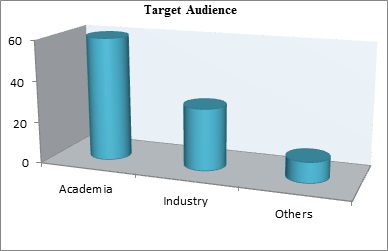
A Unique Opportunity for Advertisers and Sponsors at this International event:
http://massspectra.com/sponsors.php
Major Mass Spectrometry Associations around the Globe:
- AB Sciex Research and Development (CDN)
- ABRF (Association of Biomolecular Resource Facilities)
- Advanced Materials Technology Inc. (AMT)
- Advion BioServices, Midwest Drug Discovery, and Metabolism Center of Excellence
- American Analytical Chemistry Laboratories Corporation (AACL)
- American Association for Clinical Chemistry (AACC)
- American Society for Biochemistry and Molecular Biology (ASBMB)
- ASMS (American Society for Mass Spectrometry)
- Major Mass Spectrometry Associations in Europe
- European Proteomics Association (EuPA)
- Proteomics Societies, British Society for Proteome Research
- European Society for Separation Science (EuSSS)
- The International Association of Forensic Toxicologists
- Joint Pharmaceutical Analysis Group
- Royal Pharmaceutical Society
- American Pharmacists Association
- Generic Pharmaceutical Association(GPhA)
- Applied Pharmaceutical Association (APA)
- California Society for Separation Sciences
- Joint Pharmaceutical Analysis Group (JPAG)
Mass Spectrometry Associations in Japan:
- The Mass Spectrometry Society of Japan (MSSJ)
- Japan Industrial Safety and Health Association
- Japan Pharmaceutical Manufacturers Association(JPMA)
- The Pharmaceutical Society of Japan (PSJ)
- The Japan Society for Analytical Chemistry (JSAC)
- Japan Analytical Instruments Manufacturers' Association (JAIMA)
- Japanese Society of Pharmaceutical Health Care and Sciences
- The Japanese Society of Therapeutic Drug Monitoring
- The Japanese Peptide Society
- The Society of Electron Spin Science and Technology
- Japan Society of Amino Acid Analysis
- The Society for Chromatographic Sciences, Japan
- Japan Scientific Instruments Association (JSIA)
- Japan Analytical Instruments Manufacturers Association
- Japanese Society for Biomedical Mass Spectrometry
Statistics:
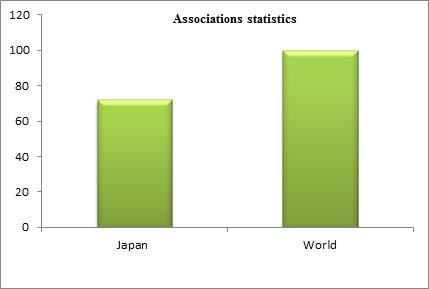
Global Mass Spectrometry market segmentation by platform:
- Hybrid Mass Spectrometry
- Triple Quadrupole Mass Spectrometry
- Quadrupole Time-of-Flight (Q TOF) Mass Spectrometry
- Fourier Transform Mass Spectrometry (FTMS)
- Single Mass Spectrometry
- Quadrupole Mass Spectrometry
- Ion Trap Mass Spectrometry
- Time-of-Flight (TOF) Mass Spectrometry
- Other Mass Spectrometry
By Application
By End User
By Geography
- North America - U.S., Canada, and Rest of North America
- Europe - Germany, France, U.K., Italy, Spain and Rest of Europe
- Asia - China, Japan, India, and Rest of Asia
- Rest of the World - Brazil, Australia and Others
Glance at Market of Analytical Instrument:
The global laboratory products market totalled $38.1 billion in 2012, with the 2013 market size forecast to reach $38.5 billion. The global laboratory products market grew 2.0% in 2012 and fell down to 1.2% in 2013 in response to global economic conditions subsequently. India and China remain the fastest growing markets analyzed expanding at CAGRs of 12.1% and 9.4%, respectively, from 2012 2015.North America is the largest market, followed by Europe and Asia. Asian market is slated to grow at the highest rate over the next five years. Asian region with emphasis on China and India. Apart from Asia, countries such as Brazil, Mexico, and Africa are also projected to have significant growth in the Mass Spectrometry Market. In the U.K., the National Institutes of Health funded the University of Cardiff with a grant of $1.2 million for biomedical research In Europe, Germany has increased its funding for research, and in the U.K.; Mass Spectrometry is used in the food testing processes.
Japan = World's 2nd largest Pharmaceutical Market!
- Japan is the 2nd largest pharmaceutical market in the world, marking JPY 10 trillion (USD 84.4
- billion) in ethical drug in 2016.
- Nikkei Stock Average has been continuously increasing since mid-October, 2016.
- The government is to ease the regulations to develop new medicines for intractable diseases by shortening 5 years of drug development time.
- Japan hugely depends on imported pharmaceutical products. The annual import value in Japan was JPY 1.94 trillion (USD 16 billion) in 2015 compared to the export value of JPY 0.32 trillion (USD 2.7 billion).
Statistics:
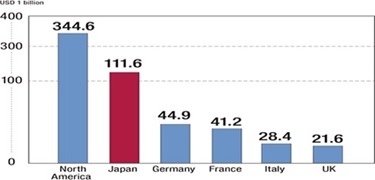
- Unit: US$ billion
- Source: Japan Pharmaceutical Manufacturers Association “Data Book 2016”
Japan’s pharmaceutical industry is the world’s second largest market, after U.S., valued at US$112.1 billion in 2012 or 11.6 percent of the world market. Historically, the market has been protected from foreign competition. These days, however, deregulation has prompted investment from abroad and increased the presence of foreign companies. The pharmaceutical industry is one of the few industrial sectors in which Japan has a trade deficit. Japan imports more than two times what it exports. The rapid aging of the population and the weak global competitiveness of domestic companies are contributing factors to the trade deficit.
Global Market Analysis of Mass spectrometry:
The global mass spectrometry market, mainly driven by technological advancements, increased pharmaceutical research, growing concern for food safety, and increase in investments, funds and grants by government bodies worldwide, was valued at $4017 million in 2013, and expected to reach $6096 million by 2019, at a CAGR of 8.7%.
The report ‘Global Mass Spectrometry Market forecast, 2012-2018’ analyzes the market by segments on the basis of technologies, such as tandem LC/MS, LC/MS-TOF, MALDI-TOF, single quadrupole, Fourier transform, and gas chromatography. The Mass Spectrometry market is predominantly driven by the tandem LC/MS technology, followed by gas chromatography, and LC/MS-TOF. With a market value of $1687.1 million and $602.6 million, Tandem LC/MS and Gas Chromatography segments have been contributing 42% and 15% respectively to the total internal beam radiotherapy devices market.
Market Value on Pharmaceutical Research:
According to World Health Organization, The global pharmaceuticals market is worth $300 billion a year, a figure that is expected to rise to $400 billion within three years. The 10 largest drugs companies in this sector have control over one-third of this market, several with the sales of more than $10 billion a year and profit margins of about 30%. Six are based in the United States and four in Europe. It is predicted that North and South America, Europe, and Japan will continue to account for a full 85% of the global pharmaceuticals market well into the 21st century.
Top Universities of Mass Spectrometry in World:
- University of Southampton
- Swansea University
- University of Cambridge
- University of Minnesota
- University of Washington
- Stanford University
- University of Birmingham
- Durham University
- University of Edinburgh
- The University of Sydney
Top Universities of Mass Spectrometry in Japan:
- Yokohoama City University, Japan
- Kansai University, Japan
- Yamanashi University, Japan
- Mukogawa Womens' University, Japan
- Kyoto University, Japan
- AIST, Japan
- Hiroshima University, Japan
- Kyoto University, Japan
- Kobe Gakuin University
- Tokushima University
Universities of Mass Spectrometry in Osaka:
- Osaka University of Pharmaceutical Sciences
- Osaka Prefecture University
- Kindai University
- Osaka City University
- Osaka Ohtani University
Statistics:

List of Mass spectrometry Companies in the World:
- 1st Detect
- AB SCIEX
- Advion
- Agilent
- Alpha Omega Technologies, Inc.
- Ametek (Dycor®)
- Bergmann Messgeraete Entwicklung (BME)
- Bruker
- Comstock, Inc.
- Evans Analytical Group
- Extrel CMS, LLC
- FLIR
- Hiden Analytical
- Hitachi Instruments
- Ion Sense Inc.
- JEOL USA
- Kore Technology, Ltd.
- Kratos Analytical
- LECO
- MassTech
- MKS Instruments
- Oerlikon
- PerkinElmer
- Pfeiffer Vacuum GmbH
- Shimadzu Scientific Instruments, Inc.
- Thermo Scientific
- Torion
- Waters Corporation
List of Mass spectrometry Companies in the Japan:
- MSI.TOKYO, INC.
- Astellas Pharma
- Chugai Pharmaceutical Co.
- Hisamitsu Pharmaceutical
- Renishaw
- Takeda Pharmaceutical Company
- Otsuka Pharmaceutical
- Rohto Pharmaceutical
List of Mass spectrometry Companies in the Osaka:
- Takeda Pharmaceutical Company Limited
Statistics:
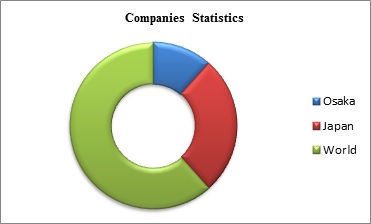
Market Growth of Mass spectrometry Research in the last and upcoming ten years:
The global mass spectrometry market was valued at $4,948.3 million in 2015, and it is expected to grow at a CAGR of 8.1% during the period 2016 - 2022. The global market is increasing, due to increasing food safety concern, growing demand in life science and clinical analysis sector, and increasing healthcare expenditure and development of healthcare infrastructure. In addition, the technological advancements with advent of Mass Spectrometry equipment are further encouraging the growth of the market.
This report studies the global mass spectrometry market for the forecast period of 2015 to 2020. This market is expected to reach USD 7,279.1 Million by 2020 from USD 4,919.9 in 2015 at a CAGR of 8.1% during the forecast period.
Statistics:

Funds allotted to Mass spectrometry Research:
Mass spectrometry is an analytical technique used to identify compounds present in a sample by measuring the mass-to-charge ratio. The market is segmented on the basis of platform and application. The Mass Spectrometry market, by platform, is segmented into Hybrid Mass Spectrometry, Single Mass Spectrometry and other Mass Spectrometry. The Mass Spectrometry market is expected to reach USD 7,279.1 Million in 2020 from USD 4,919.1 Million in 2015 at a CAGR of 8.1%.
Bibliography:
- http://www.mass-spectrometry.jp/about.html
- http://www.marketsandmarkets.com/search.asp?Search=funds+mass+spectrometry&x=0&y=0
- http://www.micromarketmonitor.com/market-report/mass-spectrometry-reports-4105177802.html
- http://www.sisweb.com/index/referenc/ms-comp.htm#Mass
- http://www.marketsandmarkets.com/PressReleases/mass-spectrometry-market.asp.
Conference Highlights
- New approaches in Mass Spectroscopy
- Infrared Spectroscopy
- Raman Spectroscopy
- UV Spectroscopy
- Time-Resolved (TR) Spectroscopy
- X-Ray Spectroscopy
- NMR Spectroscopy
- EPR Spectroscopy
- Terahertz Spectroscopy
- Chromatography
- Luminescence Spectroscopy
- Separation Techniques
- Applications of High resolution Mass Spectrometry (HPLC)
- Mass spectrometry in Medicinal chemistry
- Spectroscopy tools in Nanotechnology
- Analytical Chemistry In Veterinary Drug Analysis
- Trends in Analytical Instrumentation and Equipments
- Computed Tomography
- Mass spectrometry Detectors
- Analytical Chemistry
- Applications of Secondary Ion Mass Spectrometry (SIMS) in Materials Science
- Tandem Mass Spectrometry
To share your views and research, please click here to register for the Conference.
To Collaborate Scientific Professionals around the World
| Conference Date | Oct 17-18, 2019 | ||
| Sponsors & Exhibitors |
|
||
| Speaker Opportunity Closed | |||
| Poster Opportunity Closed | Click Here to View | ||
Useful Links
Special Issues
All accepted abstracts will be published in respective Our International Journals.
- Journal of Analytical & Bioanalytical Techniques
- Journal of Chromatography & Separation Techniques
- Pharmaceutical Analytical Chemistry: Open Access
Abstracts will be provided with Digital Object Identifier by







